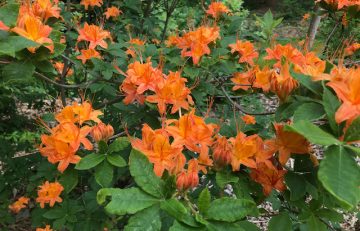
Rhododendron arborescens
I should start this month’s despatch by correcting a mistake from the May 2024 in the Garden entry, which stated that Rhododendron decorum subspecies diaprepes ‘Gargantua’ “started flowering in mid-April,” which it did not. As is its normal habit, it will be in glorious bloom in June. Mea culpa. In my defence, I was still jet-lagged and fuzzy-headed after my return from Japan. Anyway, I should know better, as my father named a particularly floriferous diaprepes seedling in his garden ‘June Wedding’. Two closely related species, Rhododendron glanduliferum and Rhododendron serotinum (examples of both species along Lower Asian Way between Kingdon Ward Way and Purdom Trail) will similarly extend the season for large, fragrant, white-flowered rhododendrons. Rhododendron glanduliferum is named for the conspicuous stalked sticky glands that clothe its new growth, and R. serotinum for its late-emerging flowers (serotinus = late).
There are several more June-flowering rhododendrons in the Asian Garden, including an array of evergreen azaleas. Most are Japanese cultivars of Rhododendron indicum (satsuki azalea) and are located at the highest point on Fortune Trail. In the E. H. Lohbrunner Alpine Garden, azalea diversity is even more evident. Although the majority of azaleas will have bloomed prior to this month, a few are later flowering and are all Asian species or cultivars—hence, located in the Asian Woodland. Rhododendron nakaharae is a Taiwanese native azalea that typically produces flowers from June to August, sprinkling its low creeping stems with an exuberance of large vermillion to cadmium-red flowers. Why this is not a more popular ground-cover is a bit of a mystery, as it was introduced into North America more than 60 years ago. The unusual satsuki azalea Rhododendron ‘Yodo-no-hikari’ forms a dense mound of grass-green foliage that partially obscures its tiny white flowers. This is an azalea for people who want to steer clear of overt expressions of floral exuberance. The flowers have a vaguely honeysuckle-like appearance, and the cultivar is not without charm. More-unusual still is Rhododendron tsusiophyllum, a true dwarf azalea from Japan, that in June produces miniature, white tubular flowers no more than about 10 mm long.
The Carolinian Forest Garden boasts several late-flowering American deciduous azaleas. Although well adapted to garden culture, most are not common in gardens. Nearly all the North American azaleas are native to the Appalachian Mountains or the eastern US. Flame azalea, Rhododendron calendulaceum, produces its brilliant yellow-orange to orange flowers from late May to late June, depending on the preceding weather conditions. The species is planted along pathways throughout the Carolinian Forest Garden, so it’s not difficult to find when flowering. While the flame azalea is among the most eye-catching of the Appalachian species, the flowers have little or no fragrance. In contrast, the white-flowered Rhododendron arborescens (sweet or smooth azalea) is highly fragrant, the flowers smelling of cinnamon. The stature and form of the species, while not exactly arborescent (tree-like), is tall and attractively layered. There are plantings of this elegant species in Lawson, Marshall, Rafinesque and Tradescant Groves. The closely-related Rhododendron viscosum (clammy or swamp azalea) blooms around the same time, with pink-budded, long-tubed, sticky white flowers. Unlike the sweet azalea, which produces abundant displays of flowers every year, our clammy azaleas have been exceptionally shy to flower (the reason there are no images of same). Perhaps this year will finally bring them into their own, so that we can enjoy their strong clove fragrance wafting through the Garden in June. Look for it in Fraser, Lawson and Rafinesque Groves. As I’ve mentioned previously, many later-flowering plants are blooming earlier than normal this year, and these azaleas may well be past flowering by early June. But take heart—there will undoubtedly be something to catch your eye in the Garden.
- Rhododendron arborescens
- Rhododendron calendulaceum
- Rhododendron decorum subsp. diaprepes ‘Gargantua’
- Rhododendron glanduliferum
- Rhododendron glanduliferum
- Rhododendron indicum
- Rhododendron indicum ‘Gyoten’
- Rhododendron indicum
- Rhododendron serotinum
- Rhododendron tsusiophyllum
- Rhododendron viscosum
- Rhododendron ‘Yodo-no-hikari’
Submitted by: Douglas Justice, Associate Director, Horticulture and Collections













This year, for the first time, two of my rhododendrons appear to have contracted’Black Spot’. Can you advise me on the best way to get rid of this disease?
Thank you very much!